One of the biggest obstacles to understanding the Bible is not recognizing context. While Christians (hopefully) know that we use a historical-grammatical hermeneutic (attempting to discern the biblical authors’ intended meaning by considering the context of the passage in question), application varies, and may not fully recognize the many ‘lenses’ of contextual layers that influence our understanding of the original writings. Gray (2019) notes six of the most basic lenses of context that we should consider as we read the Bible: cultural, historical, literary, linguistic, visual, and geographical. By understanding the context of Scripture, we find that many of the so-called ‘problems’ of the Bible are simply misinterpretation or fallacious.
The following article has been reblogged with permission from Zoo Creation. The views expressed reflect those of the author, and not necessarily those of New Creation.
For creationists, as we try to understand why the natural world is as it is, I think it’s fair to contend that there is a lens of science. Obviously, this doesn’t mean using secular assumptions as a starting point, but rather recognizing the reality of the natural world as God’s creation. We aren’t investigating fairy tales, so we may need to closely examine the scientific issues that arise through zoology, botany, geology, astronomy, physics . . .
One zoological puzzle emerges with the following passage from Paul’s transport (primarily by ship crossing the Mediterranean) from Caesarea to Rome as a prisoner, having appealed to Caesar after two years of house arrest. After leaving Crete, the ship encounters a storm that lasts fourteen days. The ship sinks off the shore of an island, but everyone on board is saved, as Paul told them would happen, having received a message from God (Acts 27: 23-24). While gathering firewood, Paul inadvertently picks up a snake:
After we were brought safely through, we then learned that the island was called [Μελίτη]. The native people showed us unusual kindness, for they kindled a fire and welcomed us all, because it had begun to rain and was cold. When Paul had gathered a bundle of sticks and put them on the fire, a viper came out because of the heat and fastened on his hand. When the native people saw the creature hanging from his hand, they said to one another, “No doubt this man is a murderer. Though he has escaped from the sea, Justice has not allowed him to live.” He, however, shook off the creature into the fire and suffered no harm. They were waiting for him to swell up or suddenly fall down dead. But when they had waited a long time and saw no misfortune come to him, they changed their minds and said that he was a god.
Acts 28: 1-6 (ESV)
This short episode has layer upon layer of context that can be investigated. The main issue for us is the identity of the ‘viper.’ We know that there are no true vipers (Family Viperidae) native to the island of Malta. Does that mean the Bible is inaccurate? Do we have to fall back on just-so stories to try and make the Biblical narrative fit the facts? We’ll explore several of the issues here, including the identity of the snake and why exactly this episode is included in Acts, but first we need to step back and look through a geographic lens.
Geographic Context: Was Paul Shipwrecked on Malta?
Malta is the traditional site for Paul’s shipwreck (noted as such, for example, in the 1599 Geneva Bible), but another island has been put forward as an alternative identification. That is due to some ambiguity in the Greek word, Μελίτη (Melitē), in the passage. The Dalmatian (Croatian) island of Mljet (Melita in Roman times) has been occasionally proposed as the shipwreck site since the work, De Administrando Imperio, of Byzantine Emperor Constantine VII Porphyrogenitus (Meinardus 1976).
Buzov (2012) noted a third island in the Mediterranean, Samothrace (in the northern Aegean Sea), was also originally known as Melite, but it isn’t a contender for the Biblical site, geographically. Another theory moved ‘Mljet’ farther south to the island of Cephalonia, but Gilchrist (1996) noted that this was well refuted shortly after publication.
The argument for the Dalmatian Mljet includes (Acworth 1973; Meinardus 1976; Buzov 2012):
a) Local traditions suggested this was the shipwreck site.
b) Mljet had an abundance of true vipers. (Today, it should be noted, the introduction of the small Indian mongoose to Mljet has greatly reduced, if not eradicated, Vipera ammodytes from the island (Barun, Simberloff, and Budinski 2010).) Acworth (1973) incorrectly asserted (‘I am credibly informed’) that there are no snakes on Malta, so believed Mljet must be the correct island.
c) There is mention by 4th century Cyprian bishop Epiphanius that Luke, author of Acts, had been in Dalmatia, possibly referring to this episode.
d) There is an absence of any mention of Malta in Paul’s writings, though he does mention Dalmatia in 2 Timothy.
e) There are certain navigational arguments regarding the difficulty of sailing westward in a northeast wind.
f) Supposedly, research by Maltese scholars in the late 20th century showed a lack of archaeological evidence for such a shipwreck.
g) The reference in Acts to the islanders as βάρβαροι (barbaroi), denotes non-Roman status, which would be unusual for Roman-occupied Malta. Malta was Carthaginian territory until captured by Rome in 218 B.C., during the Second Punic War.
Essentially, the argument for Mljet must be considered one of circumstantial evidence, much of which isn’t well supported, or focuses on the ‘absence’ of evidence, which is logically ambiguous at best. Just a few points in response (see Gilchrist (1996) for more) include:
a) It seems likely that the islanders were referred to in Acts as ‘barbarians’ because their primary language was Punic, a now-extinct variety of the Phoenician language, rather than Greek. Cardona (2021) noted that Maltese culture remained primarily Punic until the first century B.C., when archaeological evidence begins to show greater Hellenistic and Roman influence in the main town, Melite. This cultural influence may not have run throughout the island’s entire society, however, and may have centered around the political elite. In any case, it seems likely that rather than being true Roman citizens, the Maltese were considered civitates peregrinae.
b) While there may not be many Roman-era shipwrecks in the waters around Malta, Roman-era anchors (or rather the lead stocks and collars used on many Roman-era anchors) have certainly been found throughout Maltese waters. Azzopardi, Gambin, and Zerafa (2012) noted that Heritage Malta had recovered and recorded 24 lead anchor stocks provenanced from several different spots around Malta and Gozo. The authors pointed out that these artifacts refute the idea that there was a low degree of maritime activity in the region simply because there aren’t many shipwrecks. (Xlendi Bay, along Gozo, does have evidence of several shipwrecks from different periods (Wood 2008-2009; Azzopardi 2013).)
c) Hemer (1975) sufficiently refuted the navigational/meteorological issues.
d) The snake issue will be dealt with below.
The Republic of Malta consists of an archipelago. Malta is the largest island, followed by Gozo and the much smaller Comino. There are a few other small, uninhabited islands and numerous ‘rocks.’ The Maltese tradition of Paul’s shipwreck wasn’t developed until the thirteenth century. It was politically expedient to muster a patron saint for the island, as it was transformed into a fortress against Islam (Buzov 2012). As Biblical scholars analyzed the Scriptural text, and the geography of the region, however, Malta became the best answer for Paul’s shipwreck site (Keener 2015).
Interestingly, naturalist John Ray visited the island of Malta in 1664. While he disregarded certain Pauline legends (especially about the miraculous properties of St. Paul’s Grotto) as ‘monkish fancy,’ he affirmed his belief that this island was the site of the shipwreck, rather than the Dalmatian island (Dandria 2020).

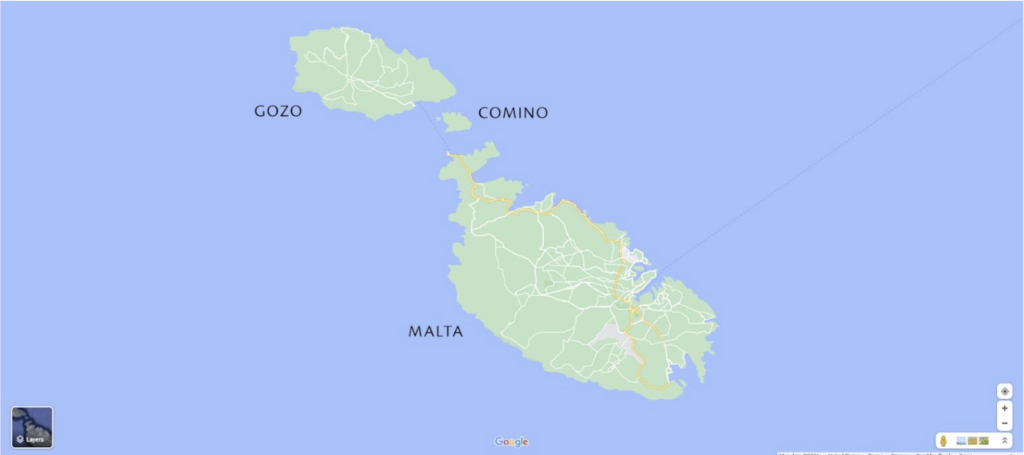
Zoological Context: The Snakes of Malta
If the island of Malta was in fact Paul’s shipwreck site, what snakes would have been on the island? While Biblical commentaries tend to be a little vague on this subject, it turns out that there is a significant body of scientific literature studying the herpetofauna of Malta.
Despott (1915) initially noted two species of snakes, the western (or green) whip snake (Hierophis viridiflavus) and the leopard snake (Zamenis situla), along with five native lizard species and one frog. Boulenger in his Snakes of Europe (1913) suggested that the western whip snake may have been Paul’s ‘viper,’ due to its ‘viciousness.’ (Whip snakes tend to bite first, and ask questions later.) The leopard snake has also been suggested as the culprit, due to superficial similarities in morphology to European vipers (Savona-Ventura 1983). Despott also noted that a cat snake (Telescopus fallax) had been found on Malta, but with only that report he was uncertain about adding it to the fauna list. Lanza (1973) described the finding of the Algerian whip snake (Hemorrhois algirus) in 1927, with additional specimens found in 1928, 1953, and 1954, all discovered in the Floriana area. These are the only four snake species known from Malta, and are all in the Family Colubridae.
Schembri and Lanfranco (1996) noted the suggestion that both the Algerian whip snake and cat snake were introduced to Malta with shipments of firewood during World War I, both becoming established primarily at Floriana (where a fuel yard had been established). They note that this theory is circumstantial at best; and of course, the cat snake was reported as early as the late 1800s.
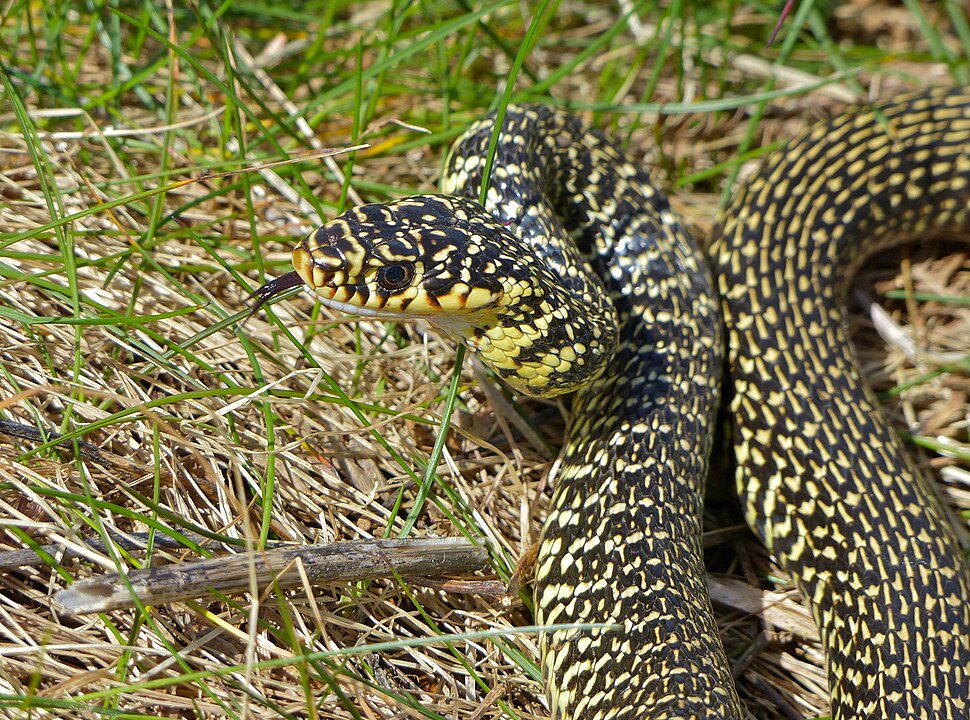
Schembri (1984) noted that the Maltese call the western whip snake (which in Malta is almost completely black), ‘Serp Iswed.’ It is the commonest species, found throughout the Maltese Islands. The leopard snake is also found on all three islands, and is called ‘Lifgha.’ (Lanfranco (1977) noted that ‘Lifgha’ is an Arabic word that just means ‘snake.’) The cat snake and the Algerian whip snake are simply called ‘Serp,’ being uncommon and only found on the Island of Malta. Schembri noted that while the latter two species being reported mostly from northeastern Malta conforms to the recent introduction theory, “since these snakes have retiring habits, and may easily be confused with other species, especially if only a fleeting glimpse is caught of the animal, they may be far more widespread than is thought. The Cat Snake may well be indigenous.” The whip snakes and leopard snake hunt during the day or at dusk, while the cat snake is nocturnal (Savona-Ventura 1985).
While Maltese reptile fossils don’t include snakes, Savona-Ventura (1984) noted that connections during the Pleistocene “resulted in a number of . . . species which have a Maltese-Balcan-Asiatic distribution,” and pointed out that that would also describe the cat snake’s distribution. The leopard snake also has an eastern Mediterranean affinity (Schembri 2003).
Could there have been a true viper on Malta that has now disappeared? Denton (1876) suggested this: “Granted that the viper is not and has not for a long time been found in Malta, it must, however, be borne in mind that the population of Malta has greatly increased from what it was in ancient times, and vipers and other venomous reptiles, like wild beasts, disappear from before the face of man, as wolves from England, and lions from Judea, where they were once common.”
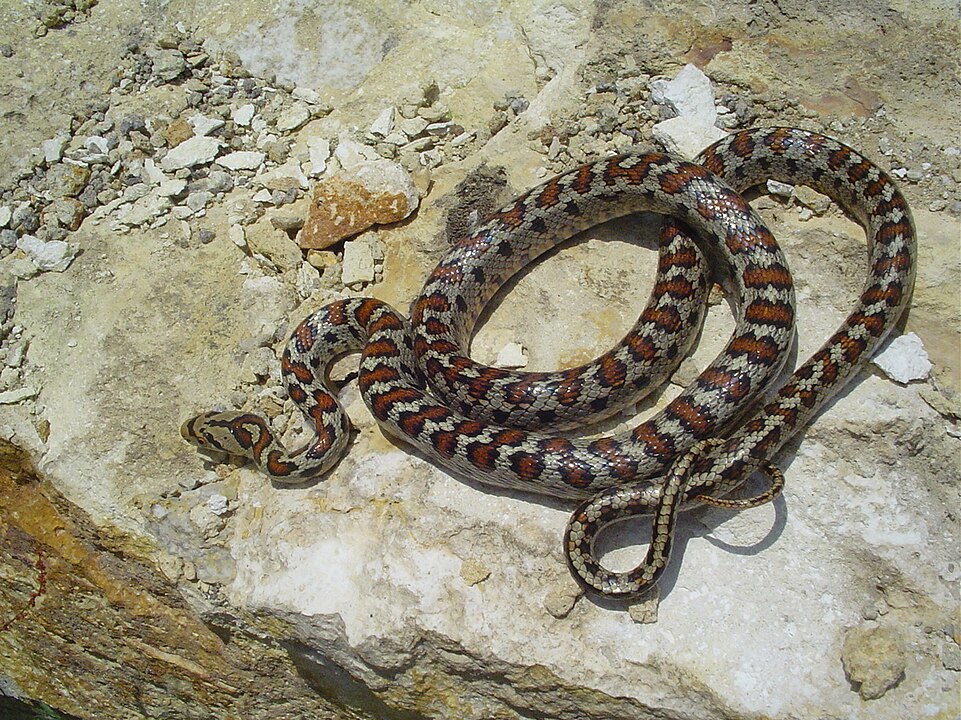
The main problem with this argument is that there is no evidence that true vipers ever existed on Malta. There are no fossil or recent remains, while wolves in England and lions in Judea have corroborating physical or cultural evidence of their past biogeography. It really doesn’t seem likely that the Maltese would have been able to so easily extirpate a viper population on their own (without, say, bringing in a predator like the mongoose) without also reducing the other snakes. Snakes appear to have healthy populations in the Maltese Islands. Looking at photographed and documented snakes in the Maltese Islands on the citizen science website iNaturalist, there are currently 16 observations between 2012 and 2021, with Hierophis viridiflavus, Telescopus fallax, and Zamenis situla all being found. (Hierophis was by far the most commonly seen, being an active and diurnal snake, but Telescopus was found in four separate locations on northwestern Malta. The Algerian whip snake doesn’t appear, and it would be interesting to know if the population failed to naturalize.)
Could the snake have been a one-off introduction? (I once saw a children’s book about this story that incorporated a young boy on the ship who had captured a small viper and brought it along on the journey in a glass jar.) Snakes and other reptiles sometimes are inadvertently transported and introduced to new locations. But Paul was gathering firewood, suggesting sticks from local brush. It is too much of a coincidence for an out-of-place snake to suddenly appear at the scene.
Toxicological Context: Venomous or Not?
Another underlying issue is whether the snake that bit Paul was venomous or not. Most Biblical commentators focus on the fact that true vipers are ‘poisonous’ while the snakes of Malta are ‘harmless.’ (I’ll use ‘venomous,’ as it is preferred terminology. Categorically, venoms are a type of poison. Most poisons are ingested, inhaled, or absorbed; venoms are injected.) More importantly, many ‘harmless’ snakes are actually venomous, though the toxins are often prey-specific. It would be more appropriate to say that there are medically-significant venomous snakes, non-medically-significant venomous snakes, and non-venomous snakes. True vipers have front fangs that inject venom, but many colubrid snakes also produce toxins even without front fangs (Minton 1990; Fry et al. 2003; Modahl, Saviola, and Mackessy 2016). Some species, like the cat snake, have enlarged, grooved rear teeth, while the western whip snake produces toxins in its saliva without having any fangs or enlarged teeth at all. Venomous colubrids were once said to have ‘Duvernoy’s glands,’ but it is now understood that these glands are simply another form of functional venom glands, and should be referred to as such (Jackson et al. 2016).
Neither the cat snake or the western whip snake would be considered medically significant under normal circumstances. (Note: I am not a doctor, and there are possible circumstances, such as allergic reactions, alcoholic intoxication, lengthy duration of bite, or a very large snake, which could exacerbate the symptoms of a bite.) Telescopus species envenomation usually only results in minor symptoms (Weinstein et al. 2011). Envenomation by Hierophis may result in temporary neurological symptoms (Weinstein et al. 2011; Dutto et al. 2013). Hemorrhois is likely a later introduction to Malta, inapplicable to Acts, but for the record, it too is a venomous colubrid, though medically insignificant (Weinstein et al. 2011).
It should be noted however, that the Maltese locals’ expectations ‘for him to swell up or suddenly fall down dead’ (especially the latter) show that they were probably unfamiliar with true viper envenomation, which argues against Paul being bitten by a true viper. The author of Acts, the physician Luke, uses medical language in the original Greek (Hobart 1882); whether he himself had any experience with snakebites, he seems to be accurately relaying the beliefs of the Maltese locals.
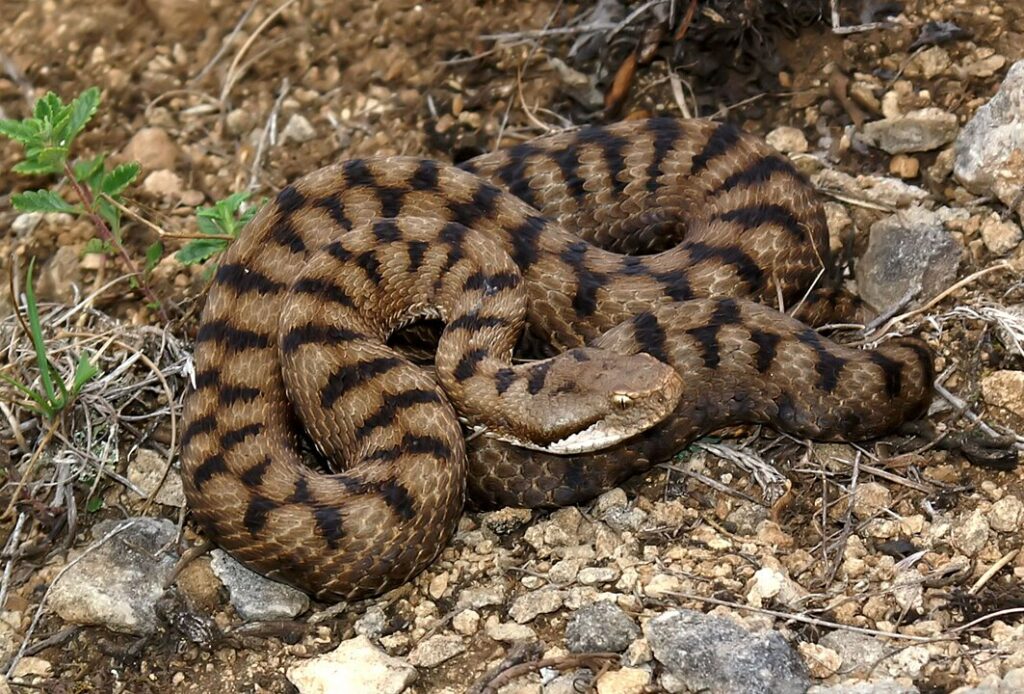
The closest European viper to Malta would be the asp viper, Vipera aspis, which is found throughout Italy (de Haro and Boels 2015). As De Haro and Boels (2015) note, 30-50% of venomous snake bites are ‘dry,’ with no venom actually injected. European viper venom is primarily hemotoxic and cytotoxic (Paolino et al. 2020). When actual envenomation occurs, there may be mild envenomation (pain, localized swelling around the bite mark), moderate envenomation (possible symptoms including swelling of the limb bitten, hematoma, adenopathy, vomiting, hypotension, fatigue, fever, labored breathing, etc.), or severe envenomation (extensive swelling, increased severity in other symptoms) (De Haro and Boels 2015; Paolino et al. 2020). Death is rare, with about five a year reported in Europe (including European regions of Turkey and Russia), out of about 7500 snakebites (with only about 1000 of those showing signs of severe envenomation) (De Haro and Boels 2015). (In a systematic review of 3800 European Vipera case studies, 0.9% deaths were recorded (Paolino et al. 2020), “with a mean time of 48.6 hours from bite to death.”) We do have modern medicine and antivenom treatment (though antivenom is only used for moderate to severe envenomation (De Haro et al. 2009)), but there still is no reason to believe that an untreated bite from a true viper would likely have resulted in Paul’s death.
Cultural Context: Snakes in the New Testament
It is important to understand that Biblical words for animals are ethnozoological, not scientific. Linnaeus’ systematic scheme of binomial nomenclature wasn’t published until the 1750s, long after Wycliffe’s English translation of the Bible in 1382 or the Tyndale Bible in 1535. Species was not a Biblical concept, and ethnozoological words could be ‘umbrella’ terms that included many different currently recognized species. While there were early attempts to distinguish snakes (particularly the dangerous ones), those were rarely reliable in pointing out specific morphological traits.
Charlesworth (2004) noted that “there are 41 nouns in ancient Greek to denote various types of snakes.” Some of the words are generic terms, while others would have been used to denote a specific type of snake. Only a few words are used in the New Testament to refer to snakes.
1. ἔχιδνα (éxidna or echidna), a venomous snake
This word is usually translated as ‘viper,’ as in ‘brood of vipers’ (Matthew 3:7; Matthew 12:34; Matthew 23:33; Luke 3:7). Luke used it to describe the snake that bit Paul in Acts 28:3. In Greek mythology, Echidna was a half-woman, half-snake monster.
2. ὄφις (ophis), a snake
This is a generic term for snakes in general, but context in the New Testament often implies dangerous serpents. Uses include, ‘they will pick up serpents’ (Mark 16:18), ‘to tread on serpents and scorpions’ (Luke 10:19), ‘You serpents’ (Matthew 23:33), and ‘as the serpent deceived Eve’ (2 Corinthians 11:3). Other Greek associations include a constellation of the ‘Serpent,’ serpent jewelry, or burrowing animals in general (Charlesworth 2004). Charlesworth (2004) noted that ophis is the usual word for snake in the New Testament, suggesting that the authors typically preferred to speak in a simple language to their readers. Paul used more diverse terms for snakes in his writings, especially in Romans, possibly suggesting a more sophisticated audience.
3. ἀσπίς (aspis), asp or cobra
This is really the only somewhat specific term used in the New Testament. It was used by Paul in the phrase ‘poison of asps’ (Romans 3:13). The asp is generally accepted to have meant the Egyptian cobra (Naja haje) complex, along with the Arabian cobra (Naja arabica), only recently distinguished as a distinct species (Trape et al. 2009). Exhibitions of Egyptian cobras in the Roman Empire date back to the first century B.C. (Bodson 2003). It is unlikely that the term would also refer to the only cobra found in Israel, however: the black desert cobra, Walterinnesia aegyptia, which is readily distinguished from Egyptian cobras. Walterinnesia lacks the ability to form a hood. When disturbed, it relies on inflating its body and hissing loudly (Zinner 1971). According to Charlesworth (2004), another term, χελιδονία, may have been used to specify the desert cobra among the ancient Greeks.
4. Δράκων (drakón), dragon or huge serpent
Ancient Greeks classified dragons as a type of serpent. The term in Revelations 12:3, etc., is used metaphorically for Satan. Senter, Mattox, and Haddad (2016) claimed that the ‘original dragons’ were ‘Aesculapian snakes and pythons,’ modified over the years by fusion with descriptions of other animals and natural phenomena. This is an old idea (see for example Alexander’s (1963) ‘The Evolution of the Basilisk’), and it is possible that large constrictors (true constrictors) were at the root of the drakón, but Aesculapian snakes, Zamenis longissimus, probably weren’t. They rely on Nicander of Colophon’s Theriaca for that theory, apparently unaware that the Theriaca was pseudo-scientific verse, full of exaggeration, inaccuracies, and outrageous ‘recipes’ (Scarborough 1977; Overduin 2009; Touwaide 2019). They seem to not recognize that Aesculapian snakes are well-known colubrids in Europe, and it is unlikely that anyone actually considered them dragons. (They are moderately large rat snakes, so they weren’t just kept in Greek temples, but were kept in houses and on farms to keep the rodent population down.) Unless corroborative evidence is found, Nicander’s description of a dragon is as likely to be tongue-in-cheek as anything else.
5. ἑρπετόν (herpeton), creeping or crawling thing, reptile, including serpents
Used in the New Testament categorically for ‘creeping things’ (James 3:7, Romans 1:23, Acts 10:12, Acts 11:6).
A sixth ‘serpent word’ is used in Acts, but isn’t intended to reference a snake there.
6. Πύθων (puthón), Python, a divining spirit, a mythical serpent
This word was used to denote a “spirit of divination” in Acts 16:16.
Hobart (1882) asserted that Luke’s use of the word θηρίον (thērion, ‘creature’ or ‘beast’ in some translations) was “exactly in the same way as the medical writers, who employed it to denote venomous serpents, and of these they applied it in particular to the viper (ἔχιδνα), so much so that an antidote, made chiefly from the flesh of vipers, was termed θηρίακή.” It shouldn’t surprise us that physician Luke might use a word common to the medical profession at the time, and it might at times have applied to venomous snakes, but Luke also uses it in Acts 11:6 as a generic term for ‘wild beasts,’ and most other uses of the word in the New Testament apply to wild beasts in general, or to the apocalyptic figure of a beast.
Folkloric Context: Maltese Superstitions
Folklore is the driving force behind most beliefs about snakes, and it has been this way for millennia. So it is odd to see assertions like this: “Luke lets us see this event through the eyes of the islanders who certainly knew their snakes better than their 276 surprise visitors and considerably better than modern commentators. The islanders expected Paul to have serious reaction to his encounter with this snake, but there was none. Rather than argue his immunity or some other explanation, can we not just accept a miracle which God performed, opening the door to wide social ministry on the island?” (Gangel 1998)
In fact, there is no reason to suspect that these Maltese islanders knew their snakes any better than the shipwrecked visitors. It is amazing, even in these ‘civilized’ times, how poorly people actually know the snakes around them. Here in Ohio, for example, it is common folklore for people to think there are ‘water moccasins’ in the creeks. That venomous species (Agkistrodon piscivorus) doesn’t occur anywhere near Ohio. Once, while I was exhibiting native reptiles at a county fair display, a farmer in southern Ohio adamantly told me that he not only had water moccasins on his property, but he had killed half a dozen large ones and stored them in his freezer. I took a trip to look at these snakes, and ended up viewing a number of very large, very dead, and perfectly harmless, northern water snakes (Nerodia sipedon). I once heard a herpetoculturist speak about his work with endangered Jamaican boas on that island. He discovered that the islanders were often terrified of the native snakes, despite none of them being venomous (or in any other way dangerous). This pattern replicates around the world. Snakes, and sometimes other reptiles, are said to have dangerous traits that just don’t exist.
Savona-Ventura (1983) suggested that expectations by the Maltese natives were likely influenced by Romans on the island who would have been familiar with the true vipers. Hemer (1975) noted that the expectations may simply have reflected fear on the islanders’ part. Both ideas likely contributed.
While we don’t have contemporaneous accounts of Maltese literature to examine for common superstitions, we know that in later years, as a Pauline cult sprang up on the island, folklore related to Paul’s snakebite became commonplace. (Of course, this occurred within the wider general context of Classical and Medieval snakebite remedies.) Snakestones, fossil sea urchin spines (Duffin 2006), and Maltese dirt or rocks chipped from ‘St. Paul’s Grotto’ (Savona-Ventura 1990), were often used to treat snakebites. Fossil shark teeth found on Malta were said to be the tongues of serpents that had been cursed into a harmless existence (Zammit-Maempel 1975), and believed to possess supernatural powers against poisons and other ailments (even as a deodorizer). Until debunked in the 1400s, some Maltese islanders claimed to be able to kill a venomous animal just by spitting on it, while, challenging the shark tooth myth, another legend claimed that the lack of venomous snakes on Malta was said to be the result of St. Paul driving them out (Savona-Ventura 2010).
(Religious beliefs in general about snakes abound in the Mediterranean region. While peripheral to this article’s subject, I found it very interesting that the village of Markopoulo on the island of Kefalonia in Greece has a tradition at a local Eastern Orthodox church, where every August a number of snakes ‘migrate’ to the church, and can be handled without fear during the Dormittion festival dedicated to the Virgin Mary. Pilgrims attend to touch the snakes, which are believed to heal them (Håland 2011). Oddly enough, the snakes in question are cat snakes, the rear-fanged, mildly venomous Telescopus fallax.)
Superstition is a powerful force, though it is only one aspect of cultural folklore. Folk beliefs and traditions may contradict reality. The evidence here suggests that the Maltese islanders did not accurately recognize the snake that bit Paul, or understand the true medical consequences of such a bite. Their superstitious beliefs are blatantly exposed when they elevate Paul to a deity for surviving the bite.
Literary Context: Luke’s Literary Devices
Why did Luke include the story of Paul’s snakebite in Acts? On the one hand, the Maltese ‘viper’ acts in this passage the same way that the Maltese falcon acts in Dashiell Hammett’s classic mystery. It’s a MacGuffin. It’s there to propel the narrative (in this case, demonstrating the superstitious nature of the Maltese natives), but Luke has no further interest in it after Paul shakes it from his hand.
While the obvious correlation within the narrative of Scripture as a whole is to Luke 10:19, “Behold, I have given you authority to tread on serpents and scorpions . . .” (ESV), that doesn’t seem to be Luke’s intent in Acts. Perhaps that isn’t surprising, as Luke 10:20 indicates that ‘serpents and scorpions’ refers more to a spiritual battlefield than to venomous organisms.
Instead, Luke appears to have had a very different point in view by including this story. The story of Philoctetes, a Greek hero whose story was told in four different plays in Ancient Greece, as well as in Homer’s Illiad, would have been well known to an educated man like Luke. Litwa (2017) argues that Luke wrote a literary aemulatio, using the main elements in Paul’s narrative to demonstrate a new type of hero.
Philoctetes was bitten by a venomous snake while shipwrecked on an island. He suffered in agony, with horrible cries, from the bite. He begs to be burned with fire, and must be healed by doctors. Paul is also bitten by a snake after being shipwrecked on an island, but in contrast, he suffers no pain from the snakebite, and makes no cry. He shakes the snake off into the fire, and goes on to become a healer himself, first praying and laying hands on Publius’ sick father, and then others who came to seek help (Acts 28: 7-9). In Luke’s narrative, Paul, by relying on God, has upstaged and overthrown the Greco-Roman concept of a hero.
Luke was a careful and artful writer, and as an eyewitness companion to Paul, he obviously noted the similarities to Philoctetes’ tale. He used this to good measure in Acts. For his purpose, it only mattered that the Maltese ‘barbarians’ thought the snake was deadly.
Summary
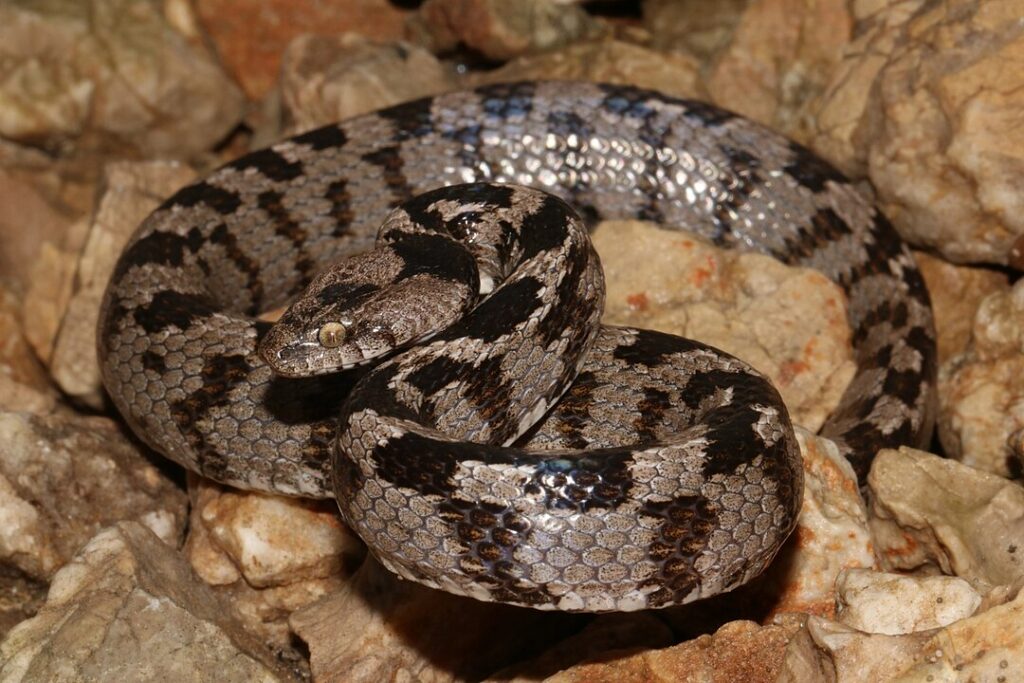
The Biblical account of Paul’s shipwreck and subsequent snakebite is sparse on zoological details, but that really wasn’t the focus of Luke’s narrative. The Bible does not state that Paul should have swollen up and died—that was a belief of the Maltese islanders, and there is no scientific or cultural evidence that such a belief was accurate. In fact, by reversing their beliefs and claiming that Paul was divine, it’s fairly obvious that they were ruled by superstition.
There is no scientific or cultural evidence for the presence of true vipers (Vipera species) on Malta. Maltese islanders were probably familiar with both the western whip snake and the leopard snake. The cat snake would have been less familiar to the locals, being uncommon in distribution and nocturnal in behavior. The cat snake’s distribution includes sites suggested for Paul’s shipwreck, making it a good candidate for the snake that bit Paul. The cat snake is mildly venomous, but Luke’s use of éxidna, as an umbrella term for venomous snakes, probably reflected the Maltese islanders’ belief that the snake was deadly.
Footnotes
Acworth, A. 1973. Where was St. Paul shipwrecked? A re-examination of the evidence. The Journal of Theological Studies N.S. 24(1): 190-193.
Alexander, R. M. 1963. The evolution of the basilisk. Greece & Rome 10(2): 170-181.
Azzopardi, E., T. Gambin, and R. Zerafa. 2008-2009. Ancient anchors from Malta and Gozo. Malta Archaeological Review (9): 22-31.
Azzopardi, E. 2013. The shipwrecks of Xlendi Bay, Gozo, Malta. Nautical Archaeology 42(2): 286-295.
Barun, A., D. Simberloff, and I. Budinski. 2010. Impact of the small Indian mongoose on native amphibians and reptiles of the Adriatic islands, Croatia. Animal Conservation 13(6): 549-555.
Bodson, L. 2003. A python, Python sebae (Gmelin, 1789), for the King: The Third Century B. C. herpetological expedition to Aithiopia. Bonner Zoologische Beiträge 52(3/4): 181-191.
Boulenger, G. A. 1913. The Snakes of Europe. London: Methusen.
Buzov, M. 2012. Is Mjlet – Melita in Dalmatia the island of St. Paul’s shipwreck? Histria Antiqua 21: 491-505.
Cardona, D. 2021. Past, present, future: An overview of Roman Malta. Open Archaeology https://doi.org/10.1515/opar-2020-0122
Charlesworth, J. H. 2004. Phenomenology, symbology, and lexicography, the amazingly rich vocabulary for ‘serpent’ in Ancient Greek. Revue Biblique 111(4): 499-515.
Dandria, D. 2020. Three early naturalists who visited Malta. The Sunday Times of Malta (May 24): 44-45.
De Haro, L., and D. Boels. 2015. European snakes. In: Brent, J., et al. (eds.). Critical Care Toxicology DOI 10.1007/978-3-319-20790-2_80-1
De Haro, L., et al. 2009. Asp viper (Vipera aspis) envenomation: Experience of the Marseille Poison Centre from 1996 to 2008. Toxins 1: 100-112.
Denton, W. 1876. A Commentary on The Acts of the Apostles. Vol. 2. London: George Bell and Sons.
Despott, G. 1915. The reptiles of the Maltese Islands. The Zoologist 19(891): 321-327.
Duffin, C. J. 2006. Lapis Judaicus or the Jews’ stone: The folklore of fossil echinoid spines. Proceedings of the Geologists’ Association 117: 265-275.
Dutto, M., et al. 2013. Snakebites by ‘harmless’ snakes: What is a venomous snake? Abstract. Toxicon 75: 207.
Fry, B. G., et al. 2003. Isolation of a neurotoxin (α-colubritoxin) from a nonvenomous colubrid: Evidence for early origin of venom in snakes. Journal of Molecular Evolution 57: 446-452.
Gangel, K. 1998. Holman New Testament Commentary: Acts. Nashville, TN: Holman Reference.
Gilchrist, J. M. 1996. The historicity of Paul’s shipwreck. Journal for the Study of the New Testament 61: 29-51.
Gray, B. 2019. The #1 Mistake Most Everyone Makes Reading the Bible. 2nd edition. ebook. Spring Hill, TN: Walking the Text.
Håland, E. J. 2011. Snakes and saints: Death, fertility, and healing in modern and ancient Greece and Italy. Performance and Spirituality 2(1): 111-151.
Hemer, C. J. 1975. Euraquilo and Melita. The Journal of Theological Studies N.S. 26(1): 100-111.
Hobart, W. K. 1882. The Medical Language of St. Luke. Dublin: Hodges, Figgis, and Co.
Jackson, T. N. W., et al. 2016. Endless forms most beautiful: the evolution of ophidian oral glands, including the venom system, and the appropriate terminology for homologous structures. Zoomorphology DOI 10.1007/s00435-016-0332-9
Keener, C. 2015. Acts: An Exegetical Commentary. Vol. 4. Grand Rapids, MI: Baker Academic.
Lanfranco, G. 1977. Some fallacies and misconceptions in the Maltese Islands. Hyphen 1(1): 34-39.
Lanza, B. 1973. Gli anfibi e i rettili delle isole circumsiciliane. Biogeografia 3: 755-804.
Litwa, M. D. 2017. Paul the ‘god’ in Acts 28: A comparison with Philoctetes. Journal of Biblical Literature 136(3): 707-726.
Meinardus, O. F. A. 1976. St. Paul shipwrecked in Dalmatia. Biblical Archeologist 39(4): 145-147.
Minton, S. A. 1990. Venomous bites from nonvenomous snakes: An annotated bibliography of colubrid envenomation. Journal of Wilderness Medicine 1: 119-127.
Modahl, C. M., A. J. Saviola, and S. P. Mackessy. 2016. Venoms of colubrids. In: Gopalakrishnakone, P., and J. J. Calvete (eds.). Venom Genomics and Proteomics. Toxinology. DOI 10.1007/978-94-007-6416-3_9
Overduin, F. 2009. The fearsome shrewmouse. Pseudo-science in Nicander’s Theriaca? pp. 79-93. In: Harder, M. A., et al. (eds.). Nature and Science in Hellenistic Poetry. Leuven, Belgium: Peeters.
Paolino, G., et al. 2020. Vipera snakebite in Europe: A systematic review of a neglected disease. Journal of the European Academy of Dermatology and Venereology https://doi.org/10.1111/jdv.16722
Savona-Ventura, C. 1983. Snakebites. Medi-Scope 3: 6-8.
Savona-Ventura, C. 1984. The fossil herpetofauna of the Maltese Islands: A review. Naturalista Sicil. S. IV 8(3-4): 93-106.
Savona-Ventura, C. 1985. The herpetofauna of the Maltese Islands. Civilization 25: 693-695.
Savona-Ventura, C. 1990. Maltese medical folklore. Maltese Medical Journal 2(1): 41-43.
Savona-Ventura, C. 2010. Maltese medical Pauline traditions. Malta Medical Journal 22(2): 34-36.
Scarborough, J. 1977. Nicander’s toxicology, 1: Snakes. Pharmacy in History 19(1): 3-23.
Schembri, P. J. 1984. Maltese snakes. Civilization 13: 350-351.
Schembri, P. J. 2003. Current state of knowledge of the Maltese non-marine fauna. In: Malta Environment and Planning Authority Annual Report and Accounts 2003. Pp. 33-65. Floriana, Malta: Malta Environmental and Planning Authority.
Schembri, P. J., and E. Lanfranco. 1996. Introduced species in the Maltese Islands. In: Baldacchino, A. E., and A. Pizzuto (eds.). Introduction of Alien Species of Flora and Fauna [proceedings] pp. 29-54. Floriana, Malta: Environmental Protection Department.
Senter, P., U. Mattox, and E. E. Haddad. 2016. Snake to monster: Conrad Gessner’s Schlangenbuch and the evolution of the dragon in the literature of natural history. Journal of Folklore Research 53(1): 67-124.
Touwaide, A. 2019. Nicander, Thêriaka, and Alexipharmaka: Venoms, poisons, and literature. Ch. 6 in: Wexler, P. (ed.) Toxicology in Antiquity. Second Edition. London: Academic Press.
Trape, J.-F., et al. 2009. Phylogeography and systematic revision of the Egyptian cobra (Serpentes: Elapidae: Naja haje) species complex, with the description of a new species from West Africa. Zootaxa 2236: 1-25.
Weinstein, S. A., et al. 2011. ‘Venomous’ Bites from Non-Venomous Snakes. Elsevier. https://doi.org/10.1016/C2010-0-68461-6
Wood, J. 2008-2009. The original discovery of the Roman shipwreck at Xlendi, Gozo. Malta Archaeological Review (9): 67-69.
Zammit-Maempel, G. 1975. Fossil sharks’ teeth: A medieval safeguard against poisoning. Melita Historica 6(4): 391-410.
Zinner, H. 1971. On ecology and the significance of semantic coloration in the nocturnal desert-elapid Walterinnesia aegyptia Lataste (Reptiles, Ophidia). Oecologia 7: 267-275.




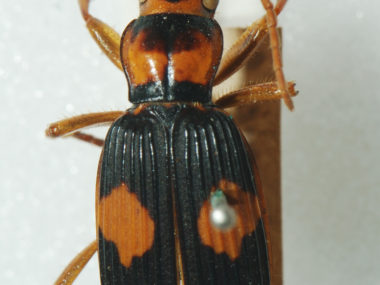







The bible says a poisonous snake bite. So its true. simply easily there were such snakes then. Viper just means that. It could be a holdover from ancient days and later killed off by the people. maybe lateer a Christian population destroyed them all in respect of the story. The vipers may of been introduced in toman or ealier times and only yook hold in some parts. Then died out. All those places had everything. its impossible and unreasonable to today say this or that didn’t exist when just over the water they did. No issue here.